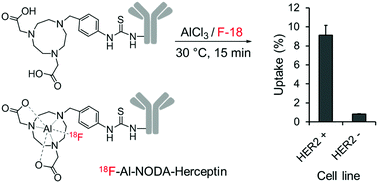Direct radiofluorination of a heat-sensitive antibody by Al–18F complexation
Abstract
18F is the most widely used radionuclide for PET imaging. However, peptides and antibodies cannot be radiolabeled with fluorine-18 without the extra attachment of an auxiliary group, and these biomolecules are typically radiolabeled indirectly through two reaction steps. The Al–18F complex has recently been developed as a new radiolabeling technique; however, the harsh conditions required for Al–18F complexation have restricted its widespread application for heat-sensitive biomolecules. Here we report fully optimized Al–18F radiofluorination enabling successful radiolabeling under mild conditions. Six different macrocyclic chelators with different backbones (NOTA, DOTA, and NODA) and pendant arms were tested for efficient radiolabeling using the Al–18F complex. We also optimized the radiolabeling conditions to achieve radiofluorination at a lower temperature by changing the radioactive fluorine source, labeling buffer, and organic solvent. By employing a NODA backbone chelator bearing two acetate pendant arms and one benzyl-NCS moiety, >60% Al–18F complexation was achieved at 30 °C in ammonium acetate buffer (pH 5.5). An antibody conjugated with the NODA chelator was also successfully radiolabeled with 18F at 30 °C using Al–18F complexation without loss of immunoreactivity.



 Please wait while we load your content...
Please wait while we load your content...